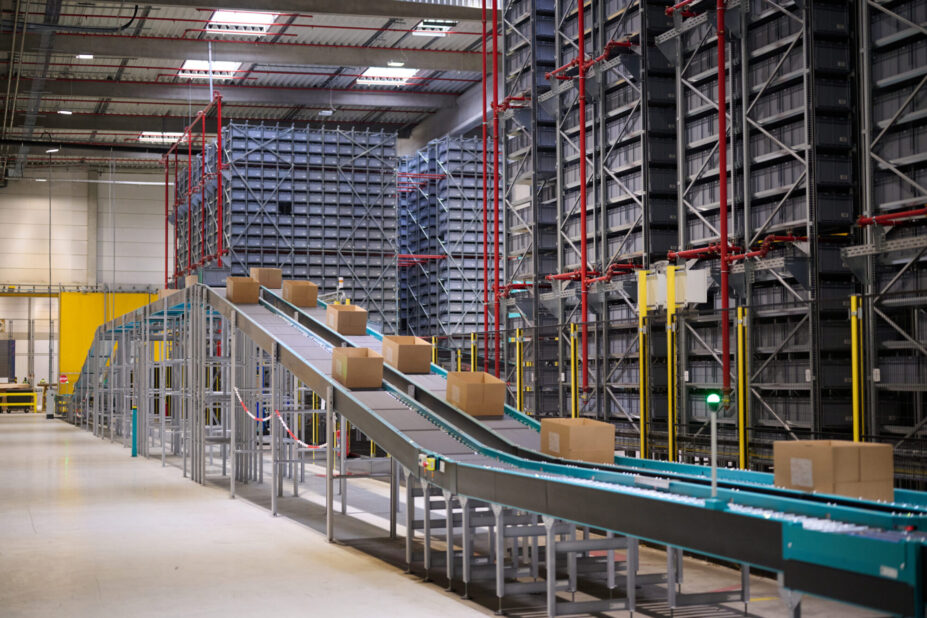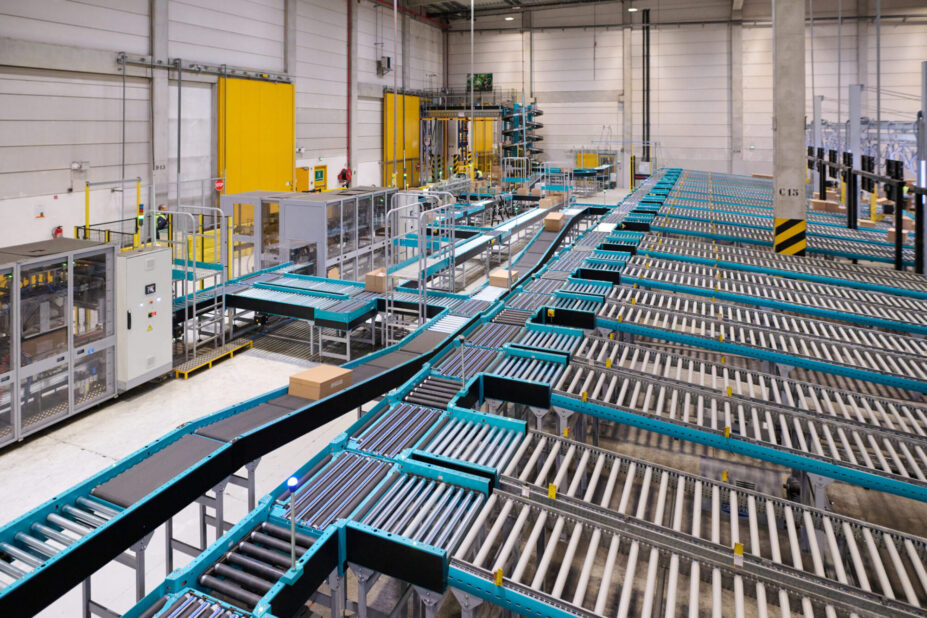Conveyor systems are the unsung heroes of countless industries, driving efficiency and automation in everything from manufacturing to food processing and warehousing. By streamlining the movement of goods, they boost productivity, enhance accuracy, cut labor costs, and improve safety for both products and employees.
This article explores the different types of conveyor systems, their significant business benefits, how they can be tailored to your specific warehouse needs, and their integration with warehouse automation systems such as Automated Storage and Retrieval Systems (ASRS).

What is a Conveyor System?
A conveyor is a mechanical handling system used to transport materials, products, or goods within a warehouse or manufacturing facility. It consists of belts, rollers, or chains that move items along a predefined path.
Many types of conveyor systems can be customized to meet a facility’s specific requirements and range from simple, manual systems to fully automated solutions.
Types of Conveyor Systems
Conveyor systems vary widely, each with unique features and advantages suitable for different applications:
- Belt Conveyors: The most common type features a continuous belt moving over pulleys. They are used extensively in manufacturing and warehouses to transport goods.
- Roller Conveyors: Utilize rollers mounted on axles to move materials, which are ideal for heavy items like pallets, drums, and bulk containers.
- Screw Conveyors: Designed for bulk materials such as grains, powders, and chemicals, using a rotating spiral screw within a tube.
- Pneumatic Conveyors: Use air pressure to move fine powders like cement, flour, and sugar through a system.
- Chain Conveyors: Chain conveyors transport materials, often used in automotive manufacturing and for heavy items.
- Bucket Conveyors: Buckets transport bulk materials, which are common in agriculture and mining vertically.
- Overhead Conveyors: Feature a track-mounted system to transport materials overhead, frequently used in automotive and manufacturing facilities.
Benefits of Conveyor Systems
Conveyor systems are among the most common forms of warehouse automation, and businesses across the globe utilize them to achieve the following benefits:
- Increased Efficiency: Automation through conveyor systems reduces reliance on manual labor, increases production speed, and results in higher output and lower costs.
- Increased Accuracy: They ensure consistent, repeatable movement of goods, reducing the likelihood of human error and improving accuracy in sorting and transporting materials.
- Cost Savings: Conveyor systems reduce labor costs, minimize product damage, and decrease material handling time.
- Improved Safety: By reducing manual material handling, conveyor systems reduce workplace injuries and the risks associated with heavy lifting.
- Space Utilization: Conveyors can be configured to maximize the use of available space, running overhead, along walls, or through tight areas to efficiently move goods.
Manual Conveyor System vs. Automated Conveyor System
Manual Conveyor Systems
Manual conveyor systems rely on some human effort to move goods, often involving pushing carts or physically carrying items along the conveyor. These systems are simple, cost-effective, and suitable for smaller operations with lower throughput demands. However, they tend to be less efficient, as they require more labor and are slower than automated alternatives.
Automated Conveyor Systems
Automated conveyor systems use motors, sensors, and control technologies to transport goods with minimal human intervention. These systems are designed to handle large volumes of materials efficiently and are ideal for high-throughput environments. They can also perform tasks like sorting, weighing, and packaging goods automatically. By reducing the need for manual labor, automated systems help cut costs, improve safety, and boost overall productivity. While the initial investment may be higher, the long-term benefits of increased efficiency and scalability make automated systems a valuable asset for growing operations.
Understanding How Conveyor Systems Work
A conveyor system consists of several components working together to move materials efficiently. The components can vary based on the system, industry, and materials, and can be tailored to meet specific operational needs. Common components typically include:
Conveyor Belt
The main component that moves materials from one point to another is powered by an electric motor.
Rollers
Mounted individually or in groups, facilitate and guide material movement along the conveyor belt. They support the load and allow smooth movement. Rollers can be powered or unpowered.
Pulleys
Drive and control the belt’s movement. Located at each end of the conveyor system, they guide and support the belt.
Motors
Power the belt and control its speed, typically running on electric power. Some motors use variable frequency drives for precise control, while others have multiple motors for flexibility.
Idlers
Support the belt’s weight and payload, reduce friction, prevent excessive wear, and ensure proper belt tracking.
Sensors
Detect and monitor object movement on the belt, providing real-time information on position, speed, and orientation for precise control and automation.
Control systems
Oversee the conveyor system’s operations, including speed, direction, and stops. They consist of a central control panel, programmable logic controllers (PLCs), and software.
Chains
Transfer materials along the system. Made of metal or plastic links, they move smoothly around sprockets or pulleys and come in various sizes and configurations.

Considerations for Implementing a Conveyor System
Understanding the unique requirements of the warehouse is the first step in choosing the right conveyor system. Factors such as the type of goods handled, volume of orders, and peak demand periods should be considered. A thorough needs assessment helps identify the tasks that can be automated and the potential benefits of implementing a conveyor system.
- Conveyor type selection: Evaluate different conveyor types (e.g., belt, roller, chain-driven, gravity) based on the specific needs, such as the type of materials handled, load capacity, and space constraints.
- Performance: Evaluate the speed at which materials are transported and how many items the conveyor system can handle per hour or day to meet your operational needs.
- Integration with other systems: Assess how the conveyor system will integrate with other automation or material handling technologies in your warehouse.
- Adaptability: Assess whether the system can be easily modified or expanded to accommodate future growth or changes in production needs.
- Space utilization: Optimize the layout to ensure the conveyor system fits well within the warehouse space without disrupting other operations.
- Compatibility: Ensure the system meets your warehouse’s safety and ergonomics standards, energy efficiency, and security requirements.
- Reliability: Assess system uptime, performance metrics, troubleshooting responsiveness, and transparency in operations.
ROI: For your ROI calculation, consider the following:
- Costs: Initial purchase, installation, and ongoing operational expenses.
- Savings: Reduced manual labor and associated costs.
- Productivity: Increased throughput and faster operations.
- Efficiency: Improved use of space, reduction in errors, and product damage.
- Growth potential: Opportunities enabled for future expansion.
- Safety: Reduced workplace injuries and related costs.

The Exotec Skypod system and Skypath automated conveyors power Renault Group’s order fulfillment operations.
The Optimal ASRS and Conveyor Solution
The Exotec Skypod system represents a leap forward in warehouse automation, seamlessly integrating advanced goods-to-person robotics with Skypath®, a plug-and-play automated conveyor solution.
The Skypod system serves as the core of order fulfillment operations, using advanced robotics to automate inventory storage and retrieval. Meanwhile, the Skypath conveyors integrate inbound and outbound operations, creating a seamless and streamlined order fulfillment process. Skypath includes straight, curved, and inclined components, capable of handling up to 2,700 bins per hour at speeds of up to 236 feet per minute.
This powerful combination reduces manual handling, minimizes errors, and significantly reduces processing times. Discover more about the Skypod system and Skypath by taking our virtual warehouse tour.
Featured In
Share
News
-
February 27,2025Colruyt‘s Collect&Go continues its automation journey with Exotec
-
February 6,2025Exotec Launches Next Generation of Skypod System, an All-in-One Robot-Based AS/RS, that Addresses the Majority of Processes Within a Warehouse
-
January 9,2025Exotec appoints new Project Operation Director to drive growth in Benelux
Events
-
April 1,2025 | ParisSITL 2025, the International Transport and Logistics Exhibition
-
May 19,2025 | BarcelonaGartner, the reference for logistics trade fairs in Europe
-
June 12,2025 | LondonRetail Gazette Efficiency Debate, in London
Ready to transform your warehouse?
Let us show you how we can take your order preparation to the next level.